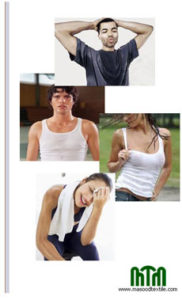More sticky garment upon sweating
(fabric stickiness is a function of capillary action which are produced as a result of inter-fiber spacing in the fabric. The capillary action forces the fabric towards the wearer skin to fill their water take in capacity when the wearer gets sweat as a result of some activity. However when we reduce the micro capillaries at the wearer skin side, by the application of non-continuous water repellant treatment, the number of micro-capillaries reduce, thus there are less available micro capillaries towards the skin side and as a result, the wearer faces less clinginess)
Slow drying rates due to sweat saturation in smaller areas
(the micro capillaries only move the water (sweat) to the next capillaries until the previous have filled their water take in capacity. Thus there is more water saturation in small area (small diameter of wetted area) of water spread to be exposed to surrounding environment and the result is slow drying rates due to slow evaporation)
Wicking is at the cost of hand feel
(for conventional wicking, it always challenging to get the good hand feel)
Less cool and comfortable wearer feel
(due to higher value of water specific heat (at room temperature 4.18J/gk much higher than the air (in room conditions ) which is 1.012 J/gk ) and more water content in the garment as a result of sweating, the heat retention properties of the micro-climate between garment and skin will be increased. This situation will be irritating and uncomfortable for the wearer and becomes more significant as a result of slow drying rates)
Garment will be totally wet in the case of high perspiration
(When all the available micro-capillaries are active, then total water absorption capacity of the fabric is high. When the fabric is using its full absorption capacity, so it will become subsequently wet in case of high level of perspiration).












